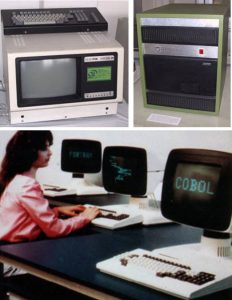VT 20 minicomputer family
The three-member machine family was developed from the VDDS (Videoton Data Display Station) video terminal family, with the addition of appropriate back-up storage and a significant expansion of the main storage. The basic model is the VT 20 minicomputer (top left image), its microprocessor-based development is the VT 20/A (top right image), and its top model is the multiprocessor VT 20/IV (bottom image), serving 1 to 4 full-fledged workstations.
The goal of developing the VT20 family was to create minicomputers that had a significantly better price/performance ratio than minicomputer-based business machines.
Use
Corporate data processing, such as
- solving administrative tasks
- accounting and payroll
- warehouse management
- invoicing
Operating distributed intelligence systems
Various reservation systems where data is required
- immediate display on the screen
- its immediate subsequent updating and
- printing
Thanks to a flexibly variable function set via microprogramming
- alphanumeric and graphic tasks (special drawing character set)
- text editing
- data transfer
- peripheral treatment, etc.
20/iV: operation of multiprocessor small business computer systems with up to 4 workstations
Structure
Central unit
Byte-organized machine: 8 bpW
- control unit:Intel 8080Amicroprocessor,
- 16-bit address bus, 8-bit data bus, control bus
- clock speed 3.125 MHz
- expandable interrupt system
- main memory: 48 KB RAM
- 20:
- 8 KB ROM
- 4k * 10 bit screen refresh rate
- 20/A, 20/IV:
- direct memory access (DMA)
- 8 KB EPROM (loadable to main memory)
- 20:
- calculator: ALU built into a microprocessor
- channel interfaces:
- up to 4 terminals (VSD) connection options
- asynchronous and synchronous transmission lines
- 20/A, 20/IV: 16-bit programmable parallel I/O port ( PIO )
Periphery
- backups:
- 5 MB / 2.5 MB MB removable magnetic disk
- 5 MB / 2.5 MB fixed disk
- 5.25″ floppy disk, 2*250 KB
- optionally 3 additional magnetic disk and 2 floppy disk drives
- external devices:
- CRT monitor
- alphanumeric keyboard (alphanumeric and numeric field, display control field, automatic character repetition)
- beep divided by 3.125 MHz clock, 16 volume levels
- cursor-moving joystick
- any VT printer; recommended types:
- matrix printer 180 chps
- line printer:
- 20: 80 / 120 chpl, 300 / 600 lpm
- 20/IV: 120 chpl, 600 / 1200 lpm
- punched tape reader/puncher
- VDN 52500 based interactive data preparation terminals:
- microprocessor (Intel 8080A) controller
- 64 KB RAM
- fitting to the central magnetic plate
Operation
Instruction set:
- 20: 78 instructions, average speed 2…9 μs/operation
- 20/A:
- 158 instructions (78 shared with VT20 predecessor)
- Index register application, indexed addressing
The central controller controlled the use of shared resources in a time-sharing mode. The sequential and index-sequential file management systems could serve up to 4 users simultaneously. The central disk also contained the printer spool.
The disks of the workstations not only contained their own operating systems, but also the necessary user and compiler programs, so they could run independently. They only had to wait for shared resources — basically shared files — which significantly accelerated the operation of the system.
The screen could be divided into fields with the same display (normal, highlighted, flashing, underlined, protected):
- resolution 25 lines, 80 chpl
- scroll to display 25 more lines
- character set: 224 normal + 64 special characters
20/IV: simultaneous service of up to 4 independent workplaces
Program set
- operating system:
- central VT-DOS (in ROM, compatible with DOS 3.10)
- logical peripheral management
- time-sharing operation
- debugging support
- compilers:
- assembler
- 20, 20/IV: VTS 56100 standard
- 20/A: For Z80 assembly language
- reloadable (INTEL) macroassembler
- BASIC interpreter, with disk management
- Fortran (optional)
- Cobol (optional)
- Pascal (optional)
- assembler
- utilities (for more general-purpose tasks)
- source text editor (compiler) (concatenation of source programs by number or by labels)
- database manager (automatic sorting by 16 types of record keys of up to 40 characters both upon entry and after deletion)
Elements of the record management macro set developed for the machine:
- Insert: add a new record
- Delete: delete record
- Read: read a record with a given key
- Read sequential: ua key-sequentially
Historical curiosities
VIDEOTON was founded in 1938 to manufacture military equipment. In the early 1950s, the company switched to the production of telecommunications products.
The VIDEOTON Development Institute, which manufactures computers and peripherals, was established in Budapest in 1969. Initially, they produced ferrite ring buffers in cooperation with Siemens, and then joined the KFKI TPA (Stored Program Analyzer) project.
From 1971 — by political decision — the development and production of the Hungarian computer, the R10, undertaken in the ESZR, began, based on the French Mitra 15 license.
In the late 1980s, the company lost its traditional markets and merged its factories to Székesfehérvár, becoming a holding company; but that's another story. (For the full story, see Factory History.)
The VT 20 was the first domestically produced computer system that a small company or cooperative could purchase, along with a magnetic disk drive and printer, and therefore attracted great interest. It is typical that the public flocked to the professional event presenting the product.
Created: 2016.01.03. 23:10
Last modified: 2025.02.25. 14:46

